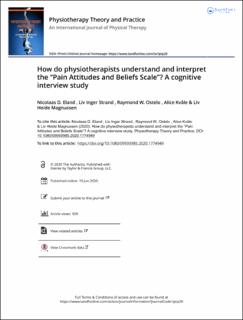| dc.contributor.author | Eland, Nicolaas Dingeman | |
| dc.contributor.author | Strand, Liv Inger | |
| dc.contributor.author | Ostelo, Raymond W.J.G. | |
| dc.contributor.author | Kvåle, Alice | |
| dc.contributor.author | Magnussen, Liv Heide | |
| dc.date.accessioned | 2021-03-01T13:51:32Z | |
| dc.date.available | 2021-03-01T13:51:32Z | |
| dc.date.created | 2020-08-18T14:47:23Z | |
| dc.date.issued | 2020-06-10 | |
| dc.Published | Physiotherapy Theory and Practice. 2020, . | |
| dc.identifier.issn | 0959-3985 | |
| dc.identifier.uri | https://hdl.handle.net/11250/2730976 | |
| dc.description.abstract | Background: The Pain Attitudes and Beliefs Scale (PABS) for physiotherapists aims to differentiate between clinicians’ biomedical and biopsychosocial treatment orientations regarding nonspecific low back pain (LBP). Objective: To study the content validity of the Norwegian PABS by following international guidelines: exploring its relevance, comprehensibility and comprehensiveness. Methods: Cognitive interviews were performed using the Three-Step Test Interview, consisting of think-aloud techniques, retrospective probing and in-depth interviews. Eleven Norwegian physiotherapists with a diversity of professional backgrounds participated. Results: The participants encountered little difficulty in completing the PABS. All items were deemed relevant and important but five items had ambiguous formulations which can easily be handled. The biomedical subscale appeared to be a comprehensive representation of biomedical treatment orientation. The biopsychosocial subscale was found to lack items concerning cognitive behavioral aspects of LBP management, such as patient education, therapeutic alliance, shared decision making and graded exposure. Conclusions: This study provides empirical evidence that the Norwegian version of the PABS-PT is relevant and comprehensible, provided some minor adjustments. The biopsychosocial subscale, however, lacks comprehensiveness, as it is not able to capture important aspects of contemporary biopsychosocial best practice care. Measurement of biopsychosocial treatment orientation may therefore be incomplete. | en_US |
| dc.language.iso | eng | en_US |
| dc.publisher | Taylor & Francis | en_US |
| dc.rights | Attribution-NonCommercial-NoDerivatives 4.0 Internasjonal | * |
| dc.rights.uri | http://creativecommons.org/licenses/by-nc-nd/4.0/deed.no | * |
| dc.title | How do physiotherapists understand and interpret the ‘Pain Attitudes and Beliefs scale’? A cognitive interview study. | en_US |
| dc.type | Journal article | en_US |
| dc.type | Peer reviewed | en_US |
| dc.description.version | publishedVersion | en_US |
| dc.rights.holder | Copyright 2020 The Author(s). | en_US |
| cristin.ispublished | true | |
| cristin.fulltext | original | |
| cristin.qualitycode | 2 | |
| dc.identifier.doi | 10.1080/09593985.2020.1774949 | |
| dc.identifier.cristin | 1823873 | |
| dc.source.journal | Physiotherapy Theory and Practice | en_US |
| dc.identifier.citation | Physiotherapy Theory and Practice, 2020 | en_US |

